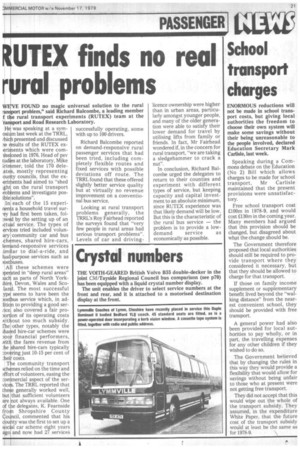ItUTEX finds no real r*ral problems
Page 23

If you've noticed an error in this article please click here to report it so we can fix it.
VVENE FOUND no magic universal solution to the rural -anSport problem," said Richard Balcombe, a leading member f the rural transport experiments (RUTEX) team at the 'ransport and Road Research Laboratory.
H was speaking at a symosi m last week at the TRRL, rhich presented and discussed te esults of the RUTEX exeri ents which were corn s oned in 1976. Head of psv tu es at the laboratory, Mike irintimer, told the 170 deleates, mostly representing ourity councils, that the exeri ents had aimed to "shed ,ghtl on the rural transport ,rob ems and investigate posible solutions".
In each of the 15 experinents a household travel sur'ey had first been taken, folDwd by the setting up of an Lct I service. The types of ervces tried included volunary community car and bus ch mes, shared hire-cars, le nd-respon sive services .itri'lar to dial-a-ride, and lual purpose services such as )ost uses.
Al these schemes were ted in "deep rural areas" ;uch as parts of North York;hire, Devon, Wales and Scolan . The most successful yp seems to have been the Kis us service which, in adiiti n to providing a good serTice also covered a fair pro)o on of its operating costs wit out too much subsidy. The other types, notably the ;ha ed hire-car schemes were 300 financial performers, it the fares revenue from :he shared hire-cars typically :ov ring just 10-15 per cent of :hei costs.
T e community transport ch mes relied on the time and Afo of volunteers, easing the mercial aspect of the servic The TRRL reported that the -e generally worked well, but that sufficient volunteers are not always available. One of t e delegates, K. Fearnside fro Shropshire County Co ncil, commented that his cou ty was the first to set up a she al car scheme eight years ago and now had 27 serviceS successfully operating, some with up to 100 drivers.
Richard Balcombe reported on demand-responsive rural passenger services that had been tried, including completely flexible routes and fixed services with possible deviations off route. The TRRL found that these offered slightly better service quality but at virtually no revenue improvement on a conventional bus service, Looking at rural transport problems generally, the TRRL's Roy Fairhead reported the surveys found that "very few people in rural areas had serious transport problems". Levels of car and driving licence ownership were higher than in urban areas, particularly amongst younger people, and many of the older generation were able to satisfy their lower demand for travel by utilising lifts from family or friends. In fact, Mr Fairhead wondered if, in the concern for rural transport, "we are taking a sledgehammer to crack a nut".
In conclusion, Richard Balcombe urged the delegates to return to their counties and experiment with different types of service, but keeping capacity and capital investment to an absolute minimum, since RUTEX experience was that likely demand will be low. But this is the characteristic of the rural bus service — the problem is to provide a low demand service as economically as possible.




























































































































































